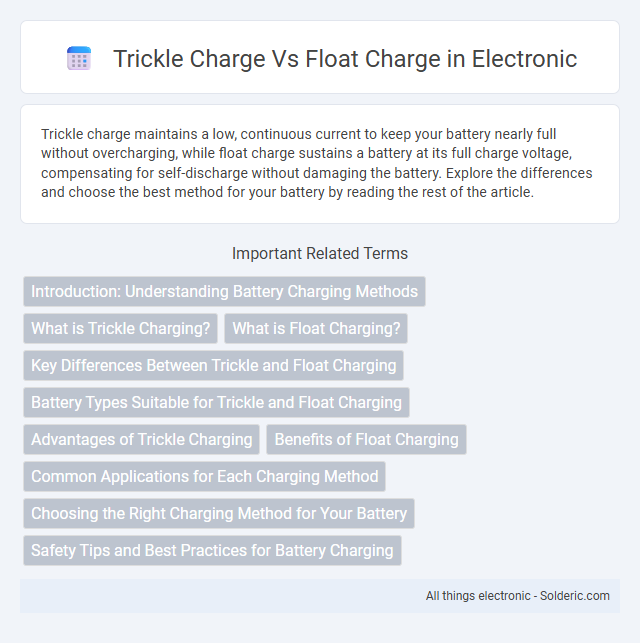Trickle charge maintains a low, continuous current to keep your battery nearly full without overcharging, while float charge sustains a battery at its full charge voltage, compensating for self-discharge without damaging the battery. Explore the differences and choose the best method for your battery by reading the rest of the article.
Comparison Table
| Aspect | Trickle Charge | Float Charge |
|---|---|---|
| Definition | Low current charging to slowly replenish battery capacity. | Constant voltage charging to maintain battery at full charge. |
| Current | Very low, usually under 0.1C (battery capacity). | Minimal current, just enough to offset self-discharge. |
| Voltage | Below battery's full charge voltage. | Set at battery's full charge voltage level. |
| Purpose | To slowly recharge a deeply discharged battery. | To maintain a fully charged battery without overcharging. |
| Application | Occasional use, emergency charging. | Continuous use in standby power systems. |
| Battery Life Impact | Can cause overcharge if not monitored. | Optimizes battery life by preventing overcharge. |
| Suitability | Best for lead-acid batteries requiring slow recharge. | Ideal for lead-acid and sealed batteries for long-term maintenance. |
Introduction: Understanding Battery Charging Methods
Trickle charge maintains a low, steady current to keep your battery fully charged without overcharging, ideal for long-term battery maintenance. Float charge provides a constant voltage that compensates for self-discharge, ensuring your battery remains at optimal capacity over time. Choosing the right method depends on your battery type and usage patterns for effective and safe charging.
What is Trickle Charging?
Trickle charging is a low-rate charging method that supplies a continuous, small amount of current to a battery, maintaining its full charge without overcharging or damaging the cells. It is commonly used for lead-acid and NiMH batteries to ensure long-term battery health during prolonged storage or inactivity. This technique prevents self-discharge by balancing the battery's voltage while minimizing heat generation and electrolyte loss.
What is Float Charging?
Float charging maintains a battery at its full charge by supplying a continuous, low-voltage current that compensates for self-discharge without overcharging. This method ensures your battery remains fully charged and ready for use over long periods, making it ideal for standby power systems. Float chargers typically operate at a voltage slightly above the battery's nominal voltage, preserving battery health and lifespan.
Key Differences Between Trickle and Float Charging
Trickle charge maintains a low, steady current to continuously replenish a battery without overcharging, making it suitable for long-term maintenance of fully charged batteries. Float charge holds the battery at a constant voltage, compensating for self-discharge by supplying just enough current to keep the battery at full capacity. The key differences include current flow--trickle charge provides a consistent small current, whereas float charge adjusts voltage precisely to minimize battery stress and extend lifespan.
Battery Types Suitable for Trickle and Float Charging
Trickle charging is ideal for lead-acid batteries, such as flooded, AGM, and gel types, because it provides a low, continuous charge that prevents overcharging while maintaining battery capacity. Float charging is best suited for sealed lead-acid and lithium-ion batteries, as it maintains a constant voltage to keep the battery fully charged without causing damage or reducing lifespan. Both charging methods support long-term battery maintenance but require appropriate settings based on the specific battery chemistry to avoid degradation.
Advantages of Trickle Charging
Trickle charging maintains your battery at a full charge by supplying a low, steady current, preventing overcharging and extending battery life. This method ensures your battery remains ready for use without the risk of damage from excess voltage. You benefit from reliable performance and reduced maintenance compared to other charging methods.
Benefits of Float Charging
Float charging maintains a battery at a full charge by supplying a constant low voltage, preventing overcharging and extending battery lifespan. It ensures reliable power availability by compensating for self-discharge without damaging the battery. Your battery remains in optimal condition, making float charging ideal for backup power systems and long-term battery maintenance.
Common Applications for Each Charging Method
Trickle charging is commonly used for maintaining small battery-powered devices such as emergency flashlights, lawn equipment, and motorcycles, where a slow, continuous charge prevents battery depletion without the risk of overcharging. Float charging is ideal for stationary batteries in backup power systems, uninterruptible power supplies (UPS), and solar energy storage, ensuring batteries remain fully charged and ready for use over extended periods. Both methods optimize battery longevity by tailoring charge rates to specific application needs.
Choosing the Right Charging Method for Your Battery
Choosing the right charging method for your battery depends on its type and usage pattern; trickle charging delivers a low, continuous current ideal for maintaining charge over long periods without overcharging, whereas float charging maintains a constant voltage level suited for keeping batteries fully charged without causing damage. Lead-acid batteries benefit from float charging to prevent sulfation during storage, while lithium-ion batteries require precise voltage control often better achieved with specialized trickle chargers. Understanding your battery's specifications and storage conditions ensures optimal longevity and performance by selecting the correct charging method.
Safety Tips and Best Practices for Battery Charging
Trickle charge maintains a low, steady current to keep your battery topped off without overcharging, making it a safer choice for long-term battery maintenance. Float charge provides a constant voltage to keep the battery fully charged while preventing damage from overcharging, ideal for standby power applications. To ensure safety, always use a charger compatible with your battery type, monitor charging temperatures, and avoid leaving batteries unattended during extended charging periods.
Trickle charge vs float charge Infographic

 solderic.com
solderic.com